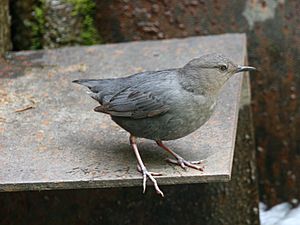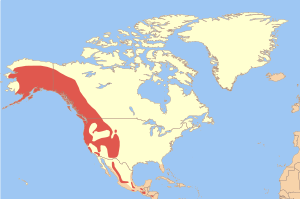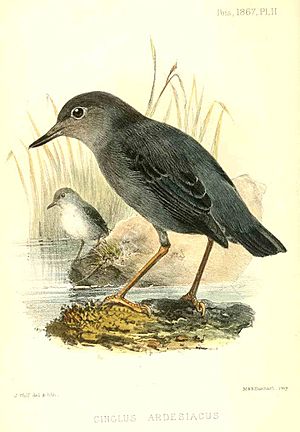American dipper facts for kids
Quick facts for kids American dipper |
|
|---|---|
 |
|
| Conservation status | |
| Scientific classification | |
 |
|
| Distribution map |

The American dipper (Cinclus mexicanus), also known as a water ouzel, is a stocky dark grey bird with a head sometimes tinged with brown, and white feathers on the eyelids that cause the eyes to flash white as the bird blinks. It is 16.5 cm (6.5 in) long, has a wingspan of 23 cm, and weighs on average 46 g (1.6 oz). It has long legs, and bobs its whole body up and down during pauses as it feeds on the bottom of fast-moving, rocky streams. It inhabits the mountainous regions of Central America and western North America from Panama to Alaska.
Taxonomy
The American dipper was described by the English zoologist William Swainson in 1827 and given the binomial name Cinclus mexicanus. The type locality is Temascaltepec de González in Mexico.
There are five subspecies:
- C. m. unicolor Bonaparte, 1827 – Alaska, west Canada and west USA
- C. m. mexicanus Swainson, 1827 – north and central Mexico
- C. m. anthonyi Griscom, 1930 – southeast Mexico, southwest Guatemala, east Honduras and northwest Nicaragua
- C. m. dickermani Phillips, AR, 1966 – south Mexico
- C. m. ardesiacus Salvin, 1867 – Costa Rica and west Panama
Description
This species, like other dippers, is equipped with an extra eyelid called a "nictitating membrane" that allows it to see underwater, and scales that close its nostrils when submerged. Dippers also produce more oil than most birds, which may help keep them warmer when seeking food underwater.
The song consists of high whistles or trills peee peee pijur pijur repeated a few times. Both sexes of this bird sing year round.
Distribution and habitat
The American dipper is usually a permanent resident, moving slightly south or to lower elevations if necessary to find food or unfrozen water. The presence of this indicator species shows good water quality; it has vanished from some locations due to pollution or increased silt load in streams.
Behaviour
The American dipper defends a linear territory along streams. In most of its habits, it closely resembles its European counterpart, the white-throated dipper, Cinclus cinclus, which is also sometimes known as a Water Ouzel.
Breeding
The American dipper's nest is a globe-shaped structure with a side entrance, close to water, on a rock ledge, river bank, behind a waterfall or under a bridge. The normal clutch is 2-4 white eggs, incubated solely by the female, which hatch after about 15–17 days, with another 20–25 days to fledging. The male helps to feed the young. The maximum recorded age from ring-recovery data of an American dipper is 8 years and 1 month for a bird ringed and recovered in South Dakota.
Feeding
It feeds on aquatic insects and their larvae, including dragonfly nymphs, small crayfish, and caddisfly larvae. It may also take tiny fish or tadpoles.
Its habit of diving underwater in search of food can infrequently make it the prey of large salmonids like bull or Dolly Varden trout.
- Erlich et al. The Birder's Handbook
- Stiles and Skutch, A guide to the birds of Costa Rica ISBN: 0-8014-9600-4
- Short radio episode The Water-Ouzel, from The Mountains of California, by John Muir 1894. California Legacy Project.
See also
 In Spanish: Mirlo acuático norteamericano para niños
In Spanish: Mirlo acuático norteamericano para niños



